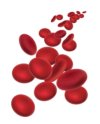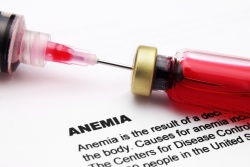Anemia
Anemia is a sign of an underlying issue with red blood cells (RBCs) and their ability to carry oxygen to tissues, resulting in hypoxia. It occurs when the total number of red cells is low or the amount of hemoglobin is low. Hemoglobin is the protein that carries oxygen on RBCs. Looking for the root cause of anemia is essential to determine the appropriate treatment. [1]
|
Anemia | |
| Causes | Dietary Factors, Heavy Metals, Medical Procedures |
|---|---|
| See Also | Cardiovascular Conditions, Iron deficiency, achlorhydria (low stomach acid), Chronic inflammation |
| Books | Books on Cardiovascular Conditions |
| Articles | Articles on Cardiovascular Conditions |
Contents
Naturopathic Assessment
Causal Factors
In order to stimulate the innate ability of the body to heal the causes of disease must be identified and addressed. With anemia, the causes are variable. A detailed assessment is required to determine which factors are contributing. Generally there are three main causes of anemia: excessive blood loss (heavy menses, hemorrhage or chronic low-volume loss), easy destruction of red blood cells (hemolysis) or deficient production of red blood cells (ineffective hematopoiesis).
Lifestyle
- Inadequate nutritional intake of iron, Vitamin B12 or folate; especially in developing countries or malnutrition in general can cause an inadequate production of red blood cells.[2]
- Skipping lunch and diets with low amounts of poultry and fish have been associated with increased risk of anemia. [2]
- Vegetarian or vegan diet can lead to iron deficiency or Vitamin B12 deficiency anemia.[3]
Social
- Economic Status
- Low socioeconomic status is commonly associated with nutritional deficiency which causes 50% of all anemia especially in school aged children leading to chronic anemia.[2]
Environment
- Lead toxicity may lead to hypochromic microcytic anemia and basophilic stippling on a peripheral smear.[4]
- Mercury toxicity is associated with low ferritin levels which may result in anemia.[5]
- Altitudes
- Normal blood values for hemoglobin and hematocrit are higher for people who live at higher altitudes [6]
Medical Interventions
- Medical Procedures
- Women with intrauterine devices (IUDs) are more likely to have iron deficiency anemia. [7]
- Procedures where portions of the stomach or intestines are removed may affect the ability to absorb iron. [7]
- Radiation can lead to aplastic anemia.[3]
- Losing large amounts of blood as from surgery, accident, childbirth or ruptured blood vessel (ie. AAA abdominal aortic aneurism, cerebral aneurism, thoracic aortic aneurysm). [1]
- Prescription Medications
- Women taking birth control are less likely to have iron deficiency anemia. [7]
- Anticonvulsant drugs including phenytoin, primidone, and phenobarbital may interfere with folate absorption resulting in megaloblastic anemia. [7]
- Mehotrexate exposure can lead to folate deficiency and anemia, [3] likewise other cancer drugs such as hydroxyurea, fluorouracil and cytarabine can cause B12 and folic acid deficiency. [1]
- Salicylates such as aspirin or willow bark can lead to iron deficiency and anemia due to blood loss from hemorrhage.[3]
- Oxidizers can activate G6PD (glucose-6-phosphate dehydrogenase) deficiency and lead to hemolytic anemia.[3]
Genetics
- Sickle cell anemia is an inherited trait common among African and Mediterranean descent.[1]
- Hemoglobin C, Hemoglobin S-C and Hemoglobin E diseases are common among African and Southeast Asian descent.[1]
- Thalassemias are inherited disorders involving the four chains of protein that make up hemoglobin. There are two alpha chains and two beta chains therefore four possible subsets of Thalassemia depending on the degree of inheritance of affected genes. Thalassemia alpha minor and beta minor, and Thalassemia alpha major and beta major.[1]
- G6PD (Glucose-6-phosphate dehydrogenase) deficiency is an x-linked recessive disorder common among African and Mediterranean males.[4]
Diagnostic Testing
The assessment of anemia is typically determined through general blood work. Symptoms of fatigue, tiredness, dizziness or general weakness can all indicate the need to assess for the presence of anemia especially in young children or menstruating women. Anemia has some direct causes or can be part of another underlying condition.
- Blood tests include red blood cell count, hematocrit and hemoglobin (included as part of a CBC).[7]
- Normal blood values for hemoglobin and hematocrit for women are 10% lower than men. [6]
- If pernicious anemia is suspected then measurements of B12 and folate should be obtained.[7]
- Iron deficiency in a male warrants investigating sources of gastrointestinal bleeds with fecal occult blood test or scope.[7]
- Other testing may include: Haptoglobin or Hemoglobin-binding Protein (HBP)
Related Symptoms and Conditions
Anemia is commonly associated with other conditions, such as:
- Chronic inflammation as from tumor or connective tissue disorder for more than a few weeks can result in anemia. [6]
- Chronic inflammation as from infection lasting more than a few weeks such as; tuberculosis, viral infections orparasites such as malaria and babesiosis. [6]
- Chronic bleeding as from gastrointestinal or urinary gradual and repetitive bleeds leading to low iron. Low iron worsens anemia and is one of the most common causes of asymptomatic anemia.[1]
- Anemia can result in increased levels of hemoglobin A1C.
- The presence of achlorhydria (low stomach acid) may lead to issues with anemia due to poor absorption of iron.[7]
- Chronic heavy menses leads to chronic blood loss and anemia. [3]
- Rheumatoid arthritis, cancer and other chronic disease processes can lead to anemia due to failure of transport of storage iron into plasma.[3]
- Hypersplenism and autoimmune disease can lead to hemolytic anemia. Autoimmune disease can also lead to aplastic anemia.[3]
- Micro-trauma to insides of vessels can lead to phagocytosis and hemolytic anemia. [3]
- Changes in plasma volume(loss of plasma)as from dehydration, diarrhea, vomiting or severe burns may falsely elevate hemoglobin and hematocrit masking anemia.[6]
- Changes in plasma volume(gain of plasma) as from pregnancy or congestive heart failure may falsely decrease hemoglobin and hematocrit confounding the extent of the anemia.[6]
Characteristics
- The symptoms of anemia can vary from none at all, only on exertion to happening at rest depending on the cause, severity and speed with which it develops. [1]
- School aged children are at risk for anemia due to increased iron demands during phases of rapid growth.[2]
- Children with refugee status or in developing countries have much higher risk for developing anemia. [2] [3]
- Elderly population are at greater risk for malabsorption leading to iron deficiency and anemia.[3]
- Pregnant women and women of reproductive age most commonly suffer from iron deficiency and anemia.[7] [3]
Common signs and symptoms:[1]
- Generally the symptoms associated with anemia can vary between no symptoms at all to weakness, vertigo, headache, tinnitus, spots before the eyes, fatigue, drowsiness, irritability, and bizarre behavior. Other signs and symptoms can include amenorrhea, loss of libido, gastrointestinal complaints, jaundice and splenomegaly.[1]
- When anemia is due to acute causes it can result in shortness of breath, organ failure or shock.
- Anemia associated with defective production can result in iron overload, heart or endocrine failure.
- Hemolytic anemia can caue skeletal abnormalities, growth retardation, jaundice and gallstones.
Morphology of different anemias:[8]
| Article | Common forms of anemia: Diagnosis and management in clinical practice, IHP, [1], Feb/March 2010 |
|---|
- Microcytic – The cells appear smaller. Associated with iron deficiency and thalassemia.
- Macrocytic – The cells appear larger. Associated with folate or B12 deficiency.
- Normocytic – The cells are the right size but they are usually shaped incorrect as in anemia of chronic disease, iron deficiency anemia (early stages), acute blood loss, hereditary spherocytosis or sickle cell disease. Hemolytic anemia is the rarest form of anemia and it is due to the excessive destruction of RBCs.[1]
Naturopathic Treatment
The goal of naturopathic treatment is to support and work in tandem with the healing power of the body and to address the causal factors of disease with individual treatment strategies. Anemia is typically treated as a chronic disease, yet there are times when it can be acute. An acute case of anemia due to blood loss should be treated as a medical emergency since if not treated can lead to heart attack, stroke or death. Treatment in this case involves blood transfusion and identifying the source of the bleeding to be stopped. [1]
It is always advisable to work with a naturopathic doctor before engaging in any treatment plan.
Lifestyle
Lifestyle recommendations include:
- Dietary recommendations include:
Naturopathic Therapies
The prescribing of naturopathic therapies requires the guidance of a naturopathic doctor as it depends on a number of factors including the causal factors, a person's age, prescription medications, other conditions and symptoms and overall health. It is always advisable to work with a naturopathic doctor prior to taking any natural therapies.
Naturopathic Therapies for anemia include:
- Nutritional Foods include: [9]
- Vegetables, Roots, Nuts & Gourds such as shiitake mushroom.
- Fish & Shellfish such as cuttlefish
- Other foods such as Royal Jelly
- Nutritional supplementation includes:
- Vitamins such as Vitamin B1 or Thiamine, Vitamin C, Vitamin B12 or Folic Acid.[1]
- Minerals such as iron,[1] calcium, Cobalt
- Other Supplements such as Chlorophyll, Spirulina, Chlorella, Betaine HCL
- Herbs such as Alfalfa (Medicago sativa), Withania or Ashwaganda (Withania somnifera), Yellow Dock (Rumex crispus), Nettle (Urtica dioica), Dandelion (Taraxacum officinale), Burdock (Arctium lappa), Ginseng (Panax ginseng), Chinese foxglove (Rehmannia), Fenugreek (Trigonella foenum-graecum), Parsley root (Petroselinum hortense), Ginger (Zingiber officinale), Gentiana (Gentiana lutea), Hawthorn (Crataegus monogyna), Wormwood (Artemisia absinthium).
- Garlic (Allium sativum''), may provide some benefits in the treatment of sickle cell anemia.[10]
- Gemmotherapies such as Abies alba, Buxus sempervirens, Ficus carica, Rosa canina, Rosmarinus officinalis, Salix alba, Tamarix gallica
- Homeopathics such as Ferrum phos, Argentum nitr.
- Tissue salts are often used to stimulate the production of blood formation.
- Foods that build blood can be helpful.
References
Reviewed by Iva Lloyd, BScH, RPE, ND [2]
- ↑ 1.00 1.01 1.02 1.03 1.04 1.05 1.06 1.07 1.08 1.09 1.10 1.11 1.12 1.13 Berga S, Bowman M, Drossman D, Faling J, Frenkel E, Gabbard G et al. editors. (1992) The Merck Manual of Diagnosis and therapy 16th edition. Rathway: Merck & Co Inc.
- ↑ 2.0 2.1 2.2 2.3 2.4 Djokic D, Drakulovic MB, Radojicic Z, Crncevic Radovic L, Rakic L, Kocic S, Davidovic G (2010) Risk factors associated with anemia among Serbian school-age children 7-14 years old: results of the first national health survey. Hippokratia;14(4):252-60. PMID:21311633
- ↑ 3.00 3.01 3.02 3.03 3.04 3.05 3.06 3.07 3.08 3.09 3.10 3.11 Piscopo Gary, Yarnell Eric. (2010) Naturopathic Clinical Boards Study Manual Volume I. Healing Mountain Publishing Inc.
- ↑ 4.0 4.1 4.2 4.3 El-Hashemy Shehab(2007)Naturopathic Standards of Primary Care CCNM Press Inc.
- ↑ tbr
- ↑ 6.0 6.1 6.2 6.3 6.4 6.5 Goldman editor. Goldman’s Cecil Medicine, 24th ed. [internet]. Saunders (2011) Chapter 161 Approach to the Anemias. [cited 2012 Jan]. Available from: http://www.mdconsult.com.ezproxy.ndnet.ca/books/page.do?eid=4-u1.0-B978-1-4377-1604-7..00161-5&isbn=978-1-4377-1604-7&uniqId=311433323-4#4-u1.0-B978-1-4377-1604-7..00161-5
- ↑ 7.0 7.1 7.2 7.3 7.4 7.5 7.6 7.7 7.8 Goroll A, Mulley A, editors.(2009) Primary Care Medicine – Office evaluation and management of the adult patient. Boston: Lippincott Williams and Wilkins
- ↑ Kumar Vinay, Abbas Abul, Fausto Nelson, Mitchell Richard, editors. (2007) Robbins Basic Pathology 8th Edition. Saunders Elselvier, Philidelphia
- ↑ Lu Henry (1986) Chinese System of Food Cures, prevention and remedies Sterling Publishing Co. New York.
- ↑ Takasu J, Uykimpang R, Sunga M, Amagase H, Niihara Y (2002) Aged garlic extract therapy for sickle cell anemia patients. BMC Blood Disorders.; 2(3).

